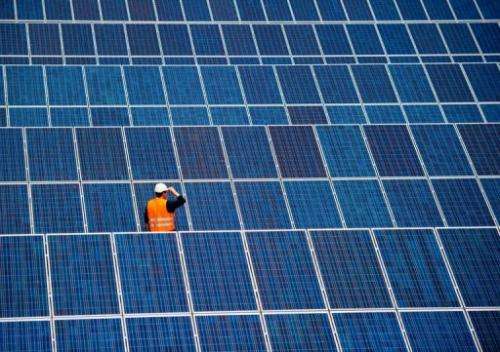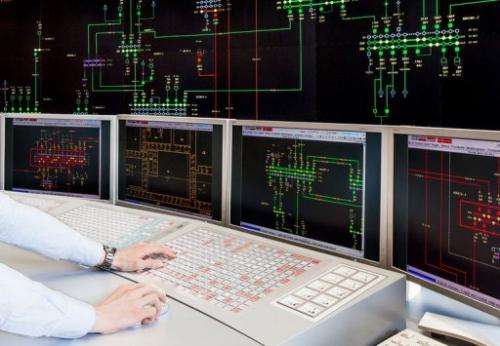German energy shift faces headwinds

Tense engineers have their eyes peeled on complex colour-coded diagrams on a wall-sized screen that makes their control room look like the inside of a spaceship.
They work with a power system that would have seemed equally futuristic not so long ago. It is also prone to solar turbulence and other unexpected flare-ups.
The technicians work at a monitoring centre of the electricity company Amprion—one of the many nerve centres of Germany's ambitious transition from nuclear to renewable energies.
Their job is to watch screens that update every three seconds to monitor about 11,000 kilometres (7,000 miles) of high-voltage power lines that criss-cross much of western Germany and extend into other European countries.
They are watching for sudden peaks and troughs, to avert dangerous power overloads or shortages, from their high-tech safety centre at Pulheim near Cologne.
"The situation changes fast, it's very volatile," says Christoph Schneiders, the centre's head of planning, pointing to the fickle nature of natural energy.
When clouds cover the sun over the solar plants that have mushroomed across Germany in recent years, he explains, the engineers see an instant drop in output. The sharp falls reverse just as quickly when the sky clears again.
"It goes up, it goes down, it is very difficult to predict," said Schneiders. And unlike a gas plant, he said, solar power can't just be switched off when there is an overload.
The hard-to-predict flow of renewable energies compared to fossil or nuclear power is one of the many challenges of the energy transition which Chancellor Angela Merkel rang in in the days after Japan's 2011 Fukushima nuclear disaster.
It is a grand project that Environment Minister Peter Altmaier once labelled "open-heart surgery on the national economy" of Europe's export-driven industrial powerhouse.

The goal is to be nuclear-free by 2022 and to combat pollution and climate change by boosting the share of clean and safe renewables to 80 percent by 2050.
Across Germany, solar panels, made popular by state subsidies and falling unit prices, now cover many home roofs and stretches of farmland.
New laws have allowed home owners to sell excess power back into the grid, while other incentives promote home insulation and other efficiency gains.
Germany's solar power capacity has risen exponentially to about 30 gigawatts now. Another 25 to 30 gigawatts come from wind farms across vast stretches of Germany's flat, coastal north and offshore parks in the North and Baltic seas.
Merkel, a physicist by training, said last week that, under optimal conditions, the total now falls just shy of Germany's usual demand of 65 to 70 gigawatts.
"During hours that are windy and sunny, a combination that is quite common, we can cover almost all of Germany's demand with renewable energy," she said.
Of course, it's not always windy and sunny, which means Germany is searching for ways to store energy, in the equivalent of giant batteries.
Another key challenge is getting the power from where it is generated, especially northern wind farms, to where it is needed, mostly the industrial centres in the south and west.
To do this Germany is planning several new north-south "power highways" which, ironically, often face opposition from environmentalists who don't want unsightly power lines cutting through forests.
Parliament last month approved a 10-billion-euro ($12.8 billion) plan to build nearly 3,000 kilometres of new high-voltage lines, and modernise 3,000 km more, for the four network operators Amprion, Tennet, 50Hertz and TransnetBW.
While the complex new system is being built, conventional power sources are being used to plug gaps in output—sometimes Schneiders and his colleagues even have to rev up a shuttered nuclear reactor again for short stretches.
The problem for power companies is that running a gas plant occasionally only to make up shortfalls is not economically viable, and several of them have closed.
There has also been a resurgence of cheap coal, considered a dirtier energy source, abetted by a market failure in the European carbon emission trade.
An oversupply in the right-to-pollute certificates has seen their price fall from an envisioned 15-18 euros per tonne of CO2 to just two to three euros—making coal plants an economically attractive option once more.
Last year German coal production—traditionally an energy mainstay in the country—rose by 4.7 percent for lignite and 5.5 percent for brown coal, and carbon emissions from coal were up four percent.
If the trend continues, it would threaten Germany's goal for 2020 of slashing carbon emissions by 40 percent from 1990 levels in a bid to help fight global climate change, melting ice caps and rising seas.
German Environment Office president Jochen Flasbarth has warned about the carbon trade that "if we cannot reform the system, we can't achieve the goal of reducing Germany's emissions".
© 2013 AFP




















